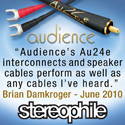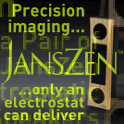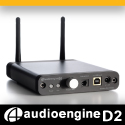|
|
You are reading the older HTML site
Positive Feedback ISSUE 62
e.a.r. Acute III CD Player as reviewed by Marshall Nack
No sooner had I finished praising the ModWright Sony SCD-XA-5400ES SACD player, going so far as to call it a giant killer, than it was bested—and not by a mega-buck component at ten times the price. Man, that didn't take long. Trusted sources pointed me to the E.A.R. Acute III CD Player.
I'm sitting in the sweet spot listening to the Sony. I'm relaxed. It still gives me ample enjoyment. It may not be perfect, but it allows my critical faculties to retreat. I won't retract anything I said about it. It's just that the Acute does that, too—and more. The Path Less TraveledE.A.R. has decided to go their own way in some of the design solutions incorporated in this product. The most obvious is an output stage that features a pair of PCC88 tubes (otherwise known as 6DJ8) and a transformer. Even more unusual are the filters employed. Filters are mandatory in digital playback and everybody uses digital filters—even knowing they don't sound good. The Acute eschews these for analog filters of their own design.
Analog-like Voicing What are the ramifications of these choices? Without a doubt, the Acute is the most analog-like digital front-end I've come across. There are two parts to explore in that statement. The Acute is a fairly small aluminum chassis, which leaves you all the more startled and impressed when it unleashes tsunami-like symphonic crescendos of the scale and magnitude normally requiring mammoth power supplies—like the ones in the Sony's tube-rectified, external power supply chassis. Equally impressive, there is no evidence of distortion / compression on crescendos. While the Sony doesn't compress either, it can't scale like the Acute.
Listening to the Brahms Sonata for Violin and Piano with Arthur Grumiaux (Pentatone PTC 5186155, SACD), via the Sony, it sounds like a vintage 1970's recording. (It was originally a Philips LP from 1974.) It sounds dated. I have to hand it to the Sony—it is wide open everywhere from 20—20,000 cycles. Through the Acute, it sounds contemporary, if not as open at the frequency extremes. BTW: the liner notes indicate the recording was made in the Concertgebouw, a world-class concert stage. However, neither player reproduces any hall ambiance.
The Acute has the full body, dense tone,
timbral colors, variety of dynamic shadings and warmth of classic
analog. While the Sony has that as well, the Acute has more. But one
thing the Sony doesn't have that the Acute offers is that elusive and
highly desirable musical flow. Notes don't end abruptly; they glide from
one to the other, they're connected.
Related to musical flow, the Acute goes
further and somehow brings musical lines to the foreground. It keeps the
beat very well has the ability to make sense out of the data stream.
This is something I've only noticed in components with transformers,
especially phono stages with step-ups. The Acute has a transformer in
the output stage, which seems to impart similar characteristics. This is
the first digital front-end I've encountered with one inline and it
sounds different.
Sidebar Discussion #1: Fidelity to Live
Sidebar Discussion #1: For sure, this
"making sense" of the data stream and the rest of the characteristics
mentioned above enhance your listening experience, making it easier for
your brain to comprehend the auditory stimuli. The Sony doesn't have the
"making sense" capability. Certainly, all of the info is there, and then
some; however multiple instrumental lines can get garbled and,
therefore, you need to work harder to make sense of the piece. Swapping
to the Acute, it seems there's just as much detail, but the gestalt gels
better. The Acute somehow brings out individual melodies without
spotlighting them too much or throwing away distracting details. Both
players sound analog-like and avoid the digital nasties, yet it is clear
that the Acute does more of the audiophile-related things and is
more pleasing and satisfying to listen to.
But is this the way we really hear? Very
often live sound is messy: it depends on the scoring of the piece, how
well it is played, and even the hall acoustics. On this count, I'd have
to give the nod to the Sony for fidelity to live.
Sidebar Discussion #2: Data Density and
Good Sound
Sidebar Discussion #2: It's been postulated
(and I'm guilty of this) that what chiefly ails digital is a lack of
continuousness due to its On/Off nature, so the theory goes. It is
comprised of slices of info and there are gaps, or voids, between the
slices. If you follow that line of thinking, the implied corrective
action is ever increasing data density. The source with the most info
will come closer to filling the gaps and achieving continuousness.
Judging by advertising volume, product buzz,
and sales, the public has been sold on this idea. The biggest trend in
the High-End is music servers delivering files of ever increasing word
size and sampling rates. The question I've asked since SACD and music
servers first hit the marketplace is: Do they sound better?
For me, the answer has been an emphatic
negative—that is, until the Sony 5400 came along. And now the Acute
outdoes it with a much lower density of info. In point of fact, the Sony
has vastly more info when playing SACD, compared to the Acute's Red
Book, even factoring in that the Acute automatically upsamples to
24/192. So, why does the Acute sound more continuous? It's because of
those selfsame analog design solutions—the transformer; the tubes; the
analog filters.
It looks to me we are once again falling
into the trap that the technology is going to save us. It's time to
re-think this. Of course, increasing data density is better, all things
being equal. But all things are never equal. At the end of the day, it
always comes back to the skills of the designer in voicing the complete
product package. In this regard, the E.A.R. has the overwhelming benefit of
Tim de Paravicini's legendary ability to design circuits. I cannot
emphasize this strongly enough—data density has to be seen as just one
element in a package. It is no panacea and guarantees nothing on its
own.
Cosmetics
The E.A.R. Acute III begins life as an Arcam
player. The transport mechanism and logic circuitry, including the
latest Wolfson DAC, are retained, but everything else is replaced.
It offers three kinds of digital
input—S/PDIF, Toslink, and USB. As I wasn't configured for these, I
solely used CDs via its transport. The front-panel volume control (also
analog) has enough gain to drive a power amplifier directly, so you
could bypass a preamp altogether. I matched volume to the Sony to
facilitate easy comparisons, which meant around 2:30 on the Acute's
volume dial.
I situated the Acute on my Vibraplane ELpF
active platform and surrounded it with K-S Elation! wires—power cord and
either balanced or single-ended ICs. Physically, the Acute is small and
weighs only 17.6 lbs and is available in black or chrome finish. The
unit is true balanced, a dual-mono design, but offers both XLR and RCA
outputs. I found the RCA outputs sounded best. Note: the IEC receptacle
for the power cord has no ground pin.
Power conditioning was iffy. While it lent
more control over the soundstage, it also began to hint at
artificiality. I preferred to use a good power strip instead, like the
Ensemble Powerpoint, as it sounded less synthetic.
ASI Top Line footers
Both of my experiments with
footers—edenSound TerraStones and ASI Top Line Footers—yielded
improvements over the built-in rubberized feet. The ASI Top Line were
best, with improvements in clarity, timbre and dynamics, but the
trade-off (there's always a downside) was reduced image scale and
fullness.
Conclusion
As you can tell, I'm rather taken with the
E.A.R. Acute III CD Player. It presented an attractive alternative to my
ModWright Sony 5400. I'll stick with my assessment of the Sony as a
giant killer—but the Acute slays it. While I found the Sony objectively
more realistic, there was no question the E.A.R. was more enjoyable to
listen to.
Without a doubt, this is the most
analog-like digital front-ends I've come across which still hews to the
right side of the neutral/euphonic continuum. The Acute accomplishes
this through the voicing skills of its legendary designer and
incorporates a host of unusual design choices.
The ModWright Sony 5400 remains a best buy,
but for a bit more cash the Acute leapfrogs it, competing with units
costing thousands of dollars more. If you are looking for an escape from
digital sterility, you should check out the E.A.R. Acute III CD Player.
Marshall Nack
Acute III CD Player
Distributor Information
E.A.R. USA
|









